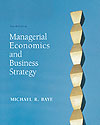This chapter reveals that different industries have different
market structures and require different types of managerial decisions. The structure
of an industry, and therefore the job of the manager, is dependent on the number
of firms in the industry, the structure of demand and costs, the availability
of information, and the behavior of other firms in the industry. The four-firm concentration ratio is one measure of market
structure. If the ratio equals one, the industry is monopolized; if it is zero
the industry is perfectly competitive. Another measure of market structure is
the Herfindahl-Hirschman Index (HHI), which can range from 10,000 for a monopoly
to zero for a perfectly competitive industry. Of course, these indices must
be used in conjunction with other information, including whether the market
is local and whether the firm competes with foreign firms. Other summary statistics include the Lerner index, the
Rothschild index, and the Dansby-Willig index. These indices provide a manager
information about industry cost and demand conditions. For instance, the greater
the Lerner index in an industry, the greater the ability of a firm in the industry
to charge a high markup on its product. The information needed to construct
these indices can be obtained from sources listed in the appendix to the chapter. The data presented in this chapter reveals industry-wide differences in
activities such as advertising and research and development. The remainder of
the book will explain why these differences exist, and the optimal managerial
decisions for alternative market structures. | 



 2002 McGraw-Hill Higher Education
2002 McGraw-Hill Higher Education